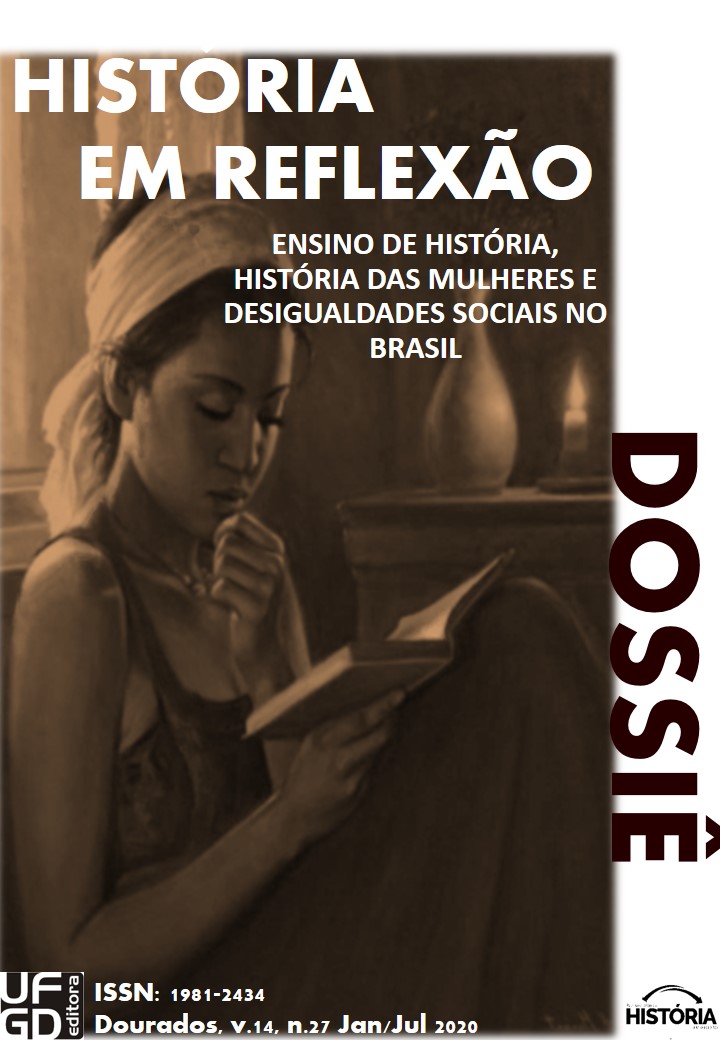Street literature in Modern England: an analysis of the representations of the criminal woman and the witchcraft in the pamphlet The most cruel and bloody murder (1606)
DOI:
https://doi.org/10.30612/rehr.v14i27.12210Keywords:
Early Modern England. Street literature. Women and witchcraft.Abstract
The present article intends to carry out an analytical examination of the representations of women and witchcraft in Modern England based on street literature, focusing on the narrative of the pamphlet The most cruel and bloody murder, published in 1606 seeking to understand the role socially played by printed in the construction of misogynistic images in the context of the reform undertaking since the 15th century in Europe.
Downloads
References
BODDICE, Rob. The history of emotions. Manchester: Manchester University Press, 2018.
BURKE, Peter. A cultura popular na Idade Moderna: Europa, 1500-1800. São Paulo: Cia das Letras, 2010.
CLARK, Sandra. Women and Crime in the Street Literature of Early Modern England. New York: Palgrave Macmillan, 2003.
CLARK, Stuart. Pensando com demônios: a ideia de bruxaria no princípio da Europa Moderna. São Paulo: EDUSP, 2006.
DELUMEAU, Jean. História do medo no Ocidente: 1300-1800, uma cidade sitiada. São Paulo: Cia. das Letras, 1989.
HILL, Alexandra, “Bloudy Tygrisses”: Murderous Women in Early Modern English Drama and Popular Literature. Electronic Theses and Dissertations. University of Central Florida, 2009.
KRAMER, Heirinch; SPRENGER, James. O Martelo das feiticeiras – Malleus maleficarum. Rio de Janeiro: Rosa dos Tempos, 1991.
LIEBEL, Silvia. Ingratas e pérfidas Medeias! Infanticídio e normatização da sexualidade feminina na literatura de rua francesa dos séculos XVI e XVII. Revista Topoi. Rio de Janeiro, v.16, n.30, pp.182-202, 2015. Disponível em: https://www.scielo.br/pdf/topoi/v16n30/2237-101X-topoi-16-30-00182.pdf Acesso em: 08 jul. 2019.
LOPES, Maria José Ferreira. De Pandora a Eva: fontes antigas da misoginia ocidental. Diacrítica, Braga, v. 26, n. 2, p. pp. 490-511, 2012. Disponível em: http://www.scielo.mec.pt/pdf/dia/v26n2/v26n2a28.pdf . Acesso em: 31 mai. 2019.
MASHBURN, Joseph H. & VELIE, Alan R. (Org). The most cruel and the bloody murder. In: Blood and knavery: a collection of English Renaissance pamphlets and ballads of crime and sin. Rutherford: Fairleigh Dickinson University Press, 1973.
MEGGS, Phillip B. & PURVIS, Alston. História do design gráfico. São Paulo: Cosac & Naif, 2009.
MUNCHEMBLED, Robert. Uma história do Diabo: séculos XII-XX. São Paulo: Bom Texto, 2001.
ORLIN, Lena Cowen. A Case for Anecdotalism in Women's History: the witness who spoke when the cock crowed. English Literary Renaissance, Chicago, v. 31, n.1, pp. 52-77, 2001.
RANKE-HEINEMANN, Uta. Eunucos pelo reino de Deus: mulheres, sexualidade e a Igreja Católica. Rio de Janeiro: Rosa dos Tempos, 1999.
RAYMOND, Joad. Pamplhets and pamphleetering in Early Modern britain. Cambridge: Cambridge University Press, 2003.
RUSSEL, Jeffrey & ALEXANDRE, Brooks. História da Bruxaria. São Paulo: Aleph, 2019.
THOMAS, Keith. Religião e o declínio da magia: crenças populares na Inglaterra - séculos XVI e XVII. São Paulo: Cia das Letras, 1991.
VASCONCELOS, Vânia N. P. Visões sobre as mulheres na sociedade ocidental. Revista Ártemis, n. 3, pp. 1-10, 2005. Disponível em: https://periodicos.ufpb.br/ojs/index.php/artemis/article/view/2209/1948. Acesso em: 08 jul. 2019.
WILTENBURG, Joy. Disorderly Women and Female Power in the Street Literature of Early Modern England and Germany. Charlottesville e Londres: University Press, 1992.
Downloads
Published
How to Cite
Issue
Section
License
Os autores devem aceitar as normas de publicação ao submeterem a revista, bem como, concordam com os seguintes termos:
(a) O Conselho Editorial se reserva ao direito de efetuar, nos originais, alterações da Língua portuguesa para se manter o padrão culto da língua, respeitando, porém, o estilo dos autores.
(b) Autores mantém os direitos autorais e concedem à revista o direito de primeira publicação, com o trabalho simultaneamente licenciado sob a Atribuição-NãoComercial-CompartilhaIgual 3.0 Brasil (CC BY-NC-SA 3.0 BR) que permite: Compartilhar — copiar e redistribuir o material em qualquer suporte ou formato e Adaptar — remixar, transformar, e criar a partir do material.
A CC BY-NC-SA 3.0 BR considera os termos seguintes:
- Atribuição: Você deve dar o crédito apropriado, prover um link para a licença e indicar se mudanças foram feitas. Você deve fazê-lo em qualquer circunstância razoável, mas de nenhuma maneira que sugira que o licenciante apoia você ou o seu uso.
- NãoComercial: Você não pode usar o material para fins comerciais.
- CompartilhaIgual: Se você remixar, transformar, ou criar a partir do material, tem de distribuir as suas contribuições sob a mesma licença que o original.
- Sem restrições adicionais: Você não pode aplicar termos jurídicos ou medidas de caráter tecnológico que restrinjam legalmente outros de fazerem algo que a licença permita.



